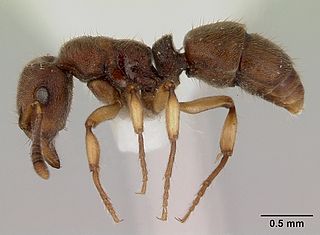
The Metopininae are a subfamily of flies in the family Phoridae.

Heteroponera is a genus of ants in the subfamily Heteroponerinae. The genus is known from the Neotropics and Australasia.

Heteroponera carinifrons is a species of ant in the genus Heteroponera, endemic to Chile. It was described by Mayr in 1887.
Heteroponera dentinodis is a species of ant in the genus Heteroponera, endemic to Chile and Brazil. It was described by Mayr in 1887.

Heteroponera flava is a species of ant in the genus Heteroponera. Endemic to Brazil and Paraguay, it was described by Kempf in 1962.
Heteroponera georgesi is a species of ant in the genus Heteroponera. Endemic to French Guiana, it was described by Perrault in 1999.
Heteroponera imbellis is a species of ant, in the genus Heteroponera. Endemic to Australia, it was described by Carlo Emery in 1895.

Heteroponera inca is a species of ant in the genus Heteroponera. Endemic to Colombia, it was described by William Louis Brown Jr. in 1958.
Heteroponera inermis is a species of ant in the genus Heteroponera. Endemic to Brazil, it was described by Carlo Emery in 1894.
Heteroponera leae is a species of ant in the genus Heteroponera. It is endemic to Australia, and was described by Wheeler in 1923. It has a similar appearance to Heteroponera crozieri ants, although H. crozieri ants are more northerly distributed.
Heteroponera majeri is a species of ant in the genus Heteroponera. Endemic to Australia, it was recently described by Taylor in 2011. Its appearance is far different to other Heteroponera species that reside in Australia.

Heteroponera mayri is a species of ant in the genus Heteroponera. Endemic to Brazil and Paraguay, it was described by Kempf in 1962.

Heteroponera microps is a species of ant in the genus Heteroponera. Endemic to South America, it was described by Borgmeier in 1957.

Heteroponera panamensis is a species of ant in the genus Heteroponera. Endemic to Costa Rica and Panama, It was described by Auguste-Henri Forel in 1899.
Heteroponera relicta is a species of ant in the genus Heteroponera. Endemic to Australia, it was described by Wheeler in 1915.
Heteroponera robusta is a species of ant in the genus Heteroponera. Endemic to Brazil, it was described by Kempf in 1962.

Pseudacteon is a genus of flies in the family Phoridae. There are over 70 described species of Pseudacteon fly. They are also known as ant-decapitating flies due to their parasitic larval stage. An egg is injected by the female fly into the shoulder joint of an ant worker. Soon after, the egg undergoes rapid inflation as it appears to absorb ant hemolymph. This first instar larva migrates into the ant head and consumes the jaw muscle and other tissues, leaving the mandibles hanging and preparing a future exit space. After about two weeks, the ant worker is termed a "zombie" because the fly larva has effectively taken control. The worker leaves the nest and dies in the leaf litter or in a crack in the soil. As it dies, the ant's head falls off, apparently because the fly larva releases an enzyme that dissolves the membrane attaching the ant's head to its body. The fly pupates in the detached head capsule, requiring a further two weeks before emerging through the ant's mouth. In tropical, subtropical areas the flies are active all year round, but in temperate regions they are active during all months except the winter months. Several Pseudacteon species were deliberately introduced to the United States to combat via biological control the invasive fire ant species Solenopsis invicta.
Thomas Borgmeier was a German-Brazilian priest and entomologist and became a specialist on the ants of Brazil and on the flies in the family Phoridae. He was also the founder of the journals Revista de Entomologia edited it from 1931 to 1951 and the Studia Entomologica from 1958.

The Metopininae is a tribe of flies in the family Phoridae.
Metopina is a genus of flies in the family Phoridae.








